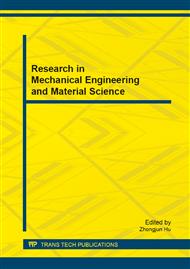p.155
p.159
p.164
p.168
p.173
p.178
p.184
p.189
p.193
Application of Modified PANS Model for Computation of Cloud Cavitation around a Clark-Y Hydrofoil
Abstract:
A density correction function was introduced to the Partially-Averaged Navier-Stokes Model (PANS) taking into account the local compressibility of two-phase mixture. The standard k-ε model, PANS model and the modified PANS model were used to simulate the unsteady cloud cavitation around a Clark-y hydrofoil and the evolutions of cavity shape, time-averaged turbulence viscosity distribution and lift coefficient variation were investigated. The results compared with experimental data show that the PANS model and the modified PANS model strongly reduce the turbulent viscosity and predict the cloud cavity shedding behavior observed in the experiment successfully, while the cavitation area and time-average lift coefficient predicted by the modified PANS model is closer to the experimental values than the original PANS model.
Info:
Periodical:
Pages:
173-177
Citation:
Online since:
October 2013
Authors:
Keywords:
Price:
Сopyright:
© 2014 Trans Tech Publications Ltd. All Rights Reserved
Share:
Citation:


